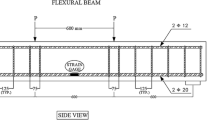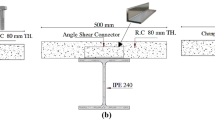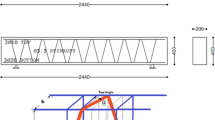Abstract
In this work, eight prestressed reinforced self-compacting concrete (SCC) beams were tested in order to investigate the shear stresses transfer mechanism, the shear failure mode and the shear performance of prestressed SCC beams without stirrups. The principal parameters included concrete compressive strength, longitudinal tensile reinforcement ratio ρ l and prestressing force. The results indicated that the shear resistance corresponding to the first flexure-shear crack increases with the amount of longitudinal tensile reinforcement and the prestressing force. The ultimate shear resistance V u increases with the increase of the concrete compressive strength. V u increases also with ρ l and the prestressing force. The failure mode of the tested beams is similar to a reinforced normal concrete beams without stirrups, namely diagonal compression failure. The diagonal crack location was analyzed in this work and the values obtained are acceptable in comparison with the test data. The shear transfer mechanism can be explained by an arch system. The predictions provided by ACI and Eurocode were compared with those obtained by the experimental test.






Similar content being viewed by others
References
AFGC, PN B@P, (2008) Recommendations for the use of self-compacting concrete. Association Française de Génie Civil, Paris
Shen J, Yurtdas I, Diagana C, Li A (2009) Mix design of self-compacting concretes for pre-cast industry. Can J Civil Eng 36:1459–1469
ACI Committee 318 (2008) Building Code Requirements for Structural Concrete (318-08) and Commentary (318R-08). Farmington Hills, American concrete institute
Eurocode 2 NF EN 1992-1-1 (2005) Design of concrete structures—Part 1-1: general rules and rules for buildings. European Committee for Standardization
Collins MP (1978) Towards a rational theory for RC members in shear. J Struct Div V104:649–666
Pang XB, Hsu TTC (1996) Fixed angle softened truss model for reinforced concrete. ACI Struct J 93:197–207
Collins MP, Mitchell D, Adebar A, Vecchio FJ (1996) A general shear design method. ACI Struct J 93:36–45
Hwang SJ, Lee HJ (2002) Strength prediction for discontinuity regions by softened strut-and-tie model. J Struct Eng 128:1519–1526
Cladera A, Marı AR (2004) Shear design procedure for reinforced normal and high-strength concrete beams using artificial neural networks. Part II: beams with stirrups. Eng Struct 26:927–936
Cladera A, Mar AR (2004) Shear design procedure for reinforced normal and high-strength concrete beams using artificial neural networks. Part I: beams without stirrups. Eng Struct 26:917–926
Bentz EC, Collins MP (2006) Development of the 2004 Canadian standards association (CSA) A23.3 shear provisions for reinforced concrete. Can J Civil Eng 33:521–534
Wolf TS, Frosch RJ (2007) Shear design of prestressed concrete: a unified approach. J Struct Eng 133:1512–1519
Hassan AAA, Hossain KMA, Lachemi M (2008) Behaviour of full-scale self-consolidating concrete beams in shear. C Conc Comp 30:588–596
Lachemi M, Hossain KMA, Lambros V (2005) Shear resistance of self-consolidating concrete beams-experimental investigations. Can J Civ Eng 32:1013–1103
Hegger J, Bülte S, Kommer B (2007) Structural behavior of prestressed beams made with self-consolidating concrete. PCI J 52:34–42
Choulli Y, Mari AR, Cladera A (2008) Shear behaviour of full-scale prestressed I-beams made with self compacting concrete. Mater Struct 41:131–141
Sonebi M, Tamimi AK, Bartos PJM (2003) Performance and cracking behavior of reinforced beams cast with self-consolidating concrete. ACI Mater J 100:492–500
Annie Peter J, Laksjmanan N, Devadas Manoharan P, Rajamane NP Gopalakrishnan S (2004). Flexural behavior of reinforced beams using self-compacting concrete. Ind Concr J pp 66–71
Reineck KH, Kuchma DA, Kim KS, Marx S (2003) Shear database for reinforced concrete members without shear reinforcement. ACI Struct J 100:240–249
EFNARC (2005) The European guidelines for concrete specification, production and use. http://www.efnarc.org/pdf/SCCGuidelinesMay2005.pdf
Kuo W, Cheng TJ, Hwang SJ (2010) Force transfer mechanism and shear strength of reinforced concrete beams. Eng Struct 32:1537–1546
Kani GNJ (1969) A rational theory for the function of web reinforcement. ACI J 63(6):185–197
Fenwick RC, Paulay T (1968) Mechanisms of shear resistance of concrete beams. J Struct Eng 94:2325–2350
Tureyen AK, Frosch RJ (2003) Concrete shear strength: another perspective. ACI Struct J 100:609–615
Muttoni A, Fernandez Ruiz M (2008) Shear strength of members without transverse reinforcement as function of critical shear crack width. ACI Struc J 105:163–172
Muttoni A, Fernandez Ruiz M (2010) Shear in slabs and beams: should they be treated in the same way? Proceeding of the workshop shear and punching shear in RC and FRC Elements, Italy: pp 105–128
Xie L, Bentz AC, Collins MP (1986) Influence of axial stress on shear response of reinforced concrete elements. ACI Struct J 108:745–755
Acknowledgments
The authors wish to thank greatly the Région Champagne-Ardenne, which supported the project entitled “Développement et Optimisation du Nouveau Béton Autoplaçant”. The authors are especially grateful to Patrick Jupillat and Jean-Marc Lointier, technicians of the civil engineering laboratory of the Université de Reims Champagne-Ardenne.
Author information
Authors and Affiliations
Corresponding author
Rights and permissions
About this article
Cite this article
Shen, J., Yurtdas, I., Diagana, C. et al. Experimental investigation on the shear performance of prestressed self-compacting concrete beams without stirrups. Mater Struct 48, 1291–1302 (2015). https://doi.org/10.1617/s11527-013-0234-y
Received:
Accepted:
Published:
Issue Date:
DOI: https://doi.org/10.1617/s11527-013-0234-y




